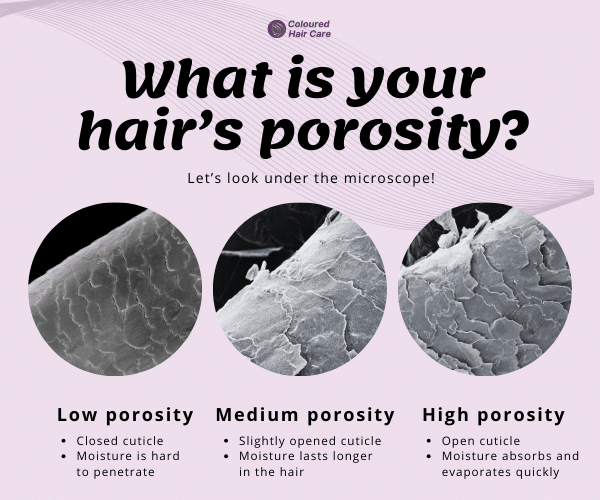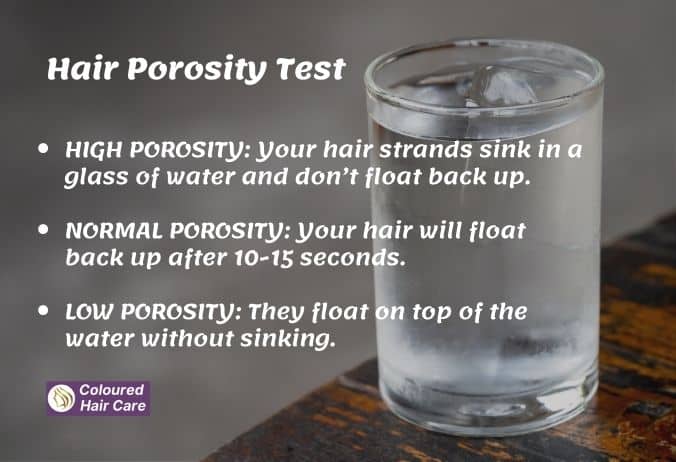Ever feel like your hair is unruly, dry, and won’t cooperate no matter what you do? Well, it might be time for you to take a hair porosity test.
Don’t know what that is? Don’t worry—we’re about to break it down for you. Let’s get into why this test is important for your hair health and how to go about taking one.
Table of Contents
- What is Hair Porosity?
- Watch and learn: Hair Porosity 101.
- The three types of hair porosity
- How to test your hair porosity
- What is super low porosity hair?
- What are signs of low porosity hair?
- What causes low porosity hair?
- Can I dye low porosity hair?
- Is low or high porosity hair better?
- Does low porosity hair mean it’s healthy?
- What products should I use for my hair porosity?
- How to care for low porosity hair.
- Parting words
What is Hair Porosity?
According to our friends at Healthline, hair porosity refers to how quickly your hair absorbs and retains moisture.
This determines what kind of products work best on your hair type and the level of care required to keep it healthy. It can also help explain why certain products don’t work as well on your hair as they do on others.
Knowing your hair porosity will give you the information you need to make an informed decision when choosing a product or styling routine that works specifically for you.

Expert Insights
“The definition of hair porosity is the ability for the hair to hold moisture. High porosity is a bad thing, it means the hair is highly damaged and very thirsty. Low porosity is a good thing, it means the hair has a tight compact healthy cuticle and repels moisture. Hair can have various degrees of porosity depending on length and number of chemical services.”
Jo Welch, Director and Educator for licensed cosm
Watch and learn: Hair Porosity 101.
Here’s a great video that talks in more detail about what hair porosity is and the right products to use if you have high porosity hair or low porosity hair.
The three types of hair porosity
There are three levels of porosity when it comes to caring for your tresses: low, normal and high.
Low porosity means that the cuticles are close together – moisture has trouble entering the cuticle layer, so deep conditioning treatments may be necessary.
Normal porosity means that the cuticles are slightly further apart – so moisture can enter and exit your hair cortex with ease, so regular conditioning should keep it looking healthy.
High porosity means there is a lot of space between cuticles – so too much moisture can easily enter the cuticle layer, leading to dryness, split ends or frizziness. Products with added oils or serums can help counteract this problem.
To get an idea of what type of hair porosity you have, try out this simple test at home!
How to test your hair porosity
Testing your own hair porosity is actually pretty easy. All you need is a bowl of warm water and several strands of clean, dry hair.
Start by gathering three or four strands of clean, dry hair from around the crown of your head. Place them gently in the bowl of warm water and wait for two minutes.
After two minutes have passed, check to see what happens to each strand. Here are some possible outcomes:
- If the strands sink immediately and don’t float back up, then this means that you have high porosity hair.
- If they take a few moments to sink but eventually float back up after 10-15 seconds then this means that you have normal porosity hair.
- If they float on top of the water without sinking at all then this means that you low porosity hair.
By testing your own strands in this way, you can easily determine whether or not you have low, normal or high porosity hair!
Once you know what kind of porosity your hair has, it’s much easier to find products tailored to those needs and will bring out the best in your mane.

What is super low porosity hair?
4C hair is a texture that is typically characterized by tightly coiled strands with a very tight zig-zag pattern that is often not visible to the naked eye.
Having “super low porosity” means that the cuticles of 4C hair are tightly packed and lie flat, making it quite challenging for water, oils, and other moisturizing treatments to penetrate the hair shaft.
This type of hair can be more prone to product build-up because products tend to sit on the hair’s surface rather than getting absorbed.
What are signs of low porosity hair?
Wondering if you have low porosity hair? Here are some telltale signs of low porosity hair to look out for:
- Quick Drying: Your hair dries fast after a shower or when exposed to the sun.
- Repels Products: Conditioners and shampoos don’t seem to penetrate well into your hair.
- Resists Deep Conditioning: Deep conditioning treatments don’t have much effect.
- Coloring Difficulties: You find it tough to color your hair.
- Tangles Easily: Your hair gets tangled quickly.
- Plastic-like Appearance: Your hair might have an overall ‘plastic-y’ look.
- Frizz and Dryness: These are common in low porosity hair.
- Genetically Low Porosity: Often seen in curly or natural hair types.
Tips for Low Porosity Hair Care.
- Avoid Over-Washing: Since low porosity hair has a natural protective barrier, it’s better not to wash it too frequently. This helps it retain more moisture.
- Embrace Your Style: No need to worry about being stuck with the same hairdo! With the right care and styling, low porosity hair can stay fresh and fabulous all week.
Expert Insights
“When my hair was super porous, it soaked up hair colour like nobody’s business – I’d try to dye it red or purple, and get pitch black. If you’re using a semi- or permanent dye (that you mix), it’ll go super dark if your hair is porous, and less so if not.”
Nikita Randall, Biomedical Scientist
What causes low porosity hair?
Here are what the professionals at WedMed tells us are the most common causes of low porosity hair:
Genetics
Genetics play a role in determining your hair type and porosity level. If you were born with low porosity strands, chances are they’ll stay that way!
Heat Damage
Overuse of heat styling tools can damage the cuticles on your strands, making them lay flat and preventing moisture from entering the strand.
When using these tools (especially tools like flat irons), make sure to use a heat protectant spray or cream before applying heat to protect your strands from damage.
Chemical Treatments and processing
As with heat styling tools, overuse of chemical treatments such as relaxers, hair bleach and color can damage the cuticle layer on your strands, resulting in low porosity hair.
When using these treatments, always follow directions carefully and consult with a professional if needed.
Age!
It’s no secret that as we age our hair tends to become more dry and brittle due to hormonal changes and other factors.
This can lead to low porosity levels in older clients who may have had high or normal porosities when they were younger.
Low Porosity Hair is just one type among many different types of textured hair out there. Understanding what causes it can help you better equip yourself to care for this unique type of hair.
Can I dye low porosity hair?
If you’ve got low porosity hair, don’t worry — yes, you can still dye it to make those fabulous color changes happen!
It’s more challenging, since the cuticles in your hair are closed and do not allow moisture or dyes to easily penetrate, but a few adjustments to your normal routine will make it possible.
- Start by pre-treating your hair with protein and keratin treatments regularly to strengthen it and increase porosity.
- When it comes time to dye, opt for an acid-based color or a semi-permanent dye that is deposited on the surface of the shafts rather than making any chemical changes.
- Use warm water when rinsing. The warmer temperature can help to gently lift the cuticles, allowing better moisture absorption and more effective cleansing of the hair and scalp. Make sure you finish up with deep conditioning treatments after each dye session.
- Use warm water when rinsing. The warmer temperature can help to gently lift the cuticles, allowing better moisture absorption and more effective cleansing of the hair and scalp. Make sure you finish up with deep conditioning treatments after each dye session.
- After conditioning, a final cold water rinse can still be beneficial for reducing frizz and adding shine, but it’s important to ensure hair has been adequately conditioned and that the cuticles have had a chance to absorb moisture and any beneficial nutrients.
Expert Insights
“When using a lift hair color on low-porosity hair, I like to apply a thin layer of Roux Porosity Control Conditioner to the hair before color application. This helps to equalize porosity and allow the chemical to penetrate evenly.”
Stephanie Johnson, Senior Cosmetologist/Trichologist
FAST FACT: Cool water rinses fail on low-porosity hair. Cool water is less efficient at dissolving and rinsing away dirt, oils, and products from the hair and scalp. This can be problematic for people with low-porosity hair because the residue left on the hair can further inhibit moisture.
Is low or high porosity hair better?
The thing about low or high hair porosity is that neither has an advantage over the other.
Low porosity hair can benefit from lighter products, while those with high porosity can really reap the rewards of deep conditioning treatments.
The key, then, isn’t about which one is ‘better’ – it’s about making sure you find the right combination of treatment and product for your individual hair texture and condition to keep you looking and feeling your best.
Everyone is different so what works for a friend might not be the same as what works for you, but regardless of low or high porosity, take some time to give yourself a little TLC and follow your routine – you’ll be glad you did!
Does low porosity hair mean it’s healthy?
Low porosity hair can be misleading – just because it’s “low” doesn’t mean it’s healthy!
But don’t assume the worst either; low-porosity hair has its positives too, like being less prone to product buildup and tangles.
Moisture is key – no matter what your level of porosity is – so make sure you’re keeping your mane hydrated with a good conditioner or deep conditioner.
Remember, there’s nothing wrong with having low-porosity hair… it just means you gotta work a little harder to keep it feeling silky smooth!
What products should I use for my hair porosity?
For low-porosity hair, look for products that are light and moisturizing—think leave-in conditioners or oil treatments applied before shampooing or conditioning.
For high-porosity strands, heavier products like deep conditioners are best since they can help keep moisture locked in longer.
And if your results come back as medium-porosity (lucky!), then both light/moisturizing products and heavy/hydrating ones should work well for you!
Just remember to experiment with different types until you find what works best for your tresses.
How to care for low porosity hair.
Caring for beautiful, low porosity hair is easier than it seems — and no matter whether you have straight, curly or natural hair, these tips will keep your strands happy and healthy!
Start by using a clarifying shampoo to remove any product buildup that might be blocking moisture from getting in.
Deep condition with an oil-based moisturizer or serum at least once a month since low porosity hair needs intense hydration.
After you wash, gently blot your strands to dry them instead of rubbing them dry with a towel (which can cause frizz).
Always use a good heat protectant before reaching for those flat irons or blow dryer.
And last but not least, be kind to yourself. A good hair day is possible when you recognize the unique needs of your fabulous tendrils.
Parting words
Achieving great looking tresses can be tricky business sometimes!
But understanding why certain products work better than others can save you lots of frustration (and money) in trying to find something that works best with YOUR kind of locks.
Taking a quick and easy (not to mention free!) DIY hair porosity test can help unlock exactly what kind of care works best for you in terms of moisture retention and product selection—which means beautiful happy locks for everyone!
So go ahead—take that test today! Your mane will thank you tomorrow!
Found your perfect shade? We’d love to see it! Tag us on Instagram @colouredhaircare or Facebook and share your hair dye success stories. Looking for more hair care tips? Check out How to Look After Colored Hair: 11 Expert Secrets For Long-Lasting Color.

